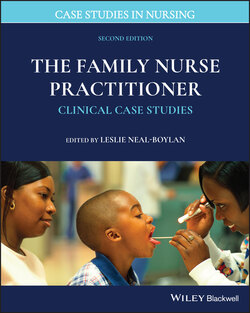Читать книгу The Family Nurse Practitioner - Группа авторов - Страница 31
ОглавлениеCase 3.6 Lesion on Penis
By Mikki Meadows‐Oliver, PhD, RN, FAAN
SUBJECTIVE
Two‐year‐old Lydell presents to the office with his mother and maternal grandmother with a complaint of a red area on his penis. Lydell’s mother, Stacy, states that when she was changing his diaper 2 days ago, she noticed that Lydell’s foreskin was red. She states that she has been putting a diaper rash cream on the area but that it has not helped to relieve the redness. She feels that the area of redness is getting larger and that the area is now painful. Lydell has no fever, cough, runny nose, vomiting, or diarrhea.
Diet: Lydell’s nutrition history reveals that he has a balanced diet with enough dairy, protein, fruits, and vegetables. His appetite is good and has not changed in the past 2 days.
Elimination: Lydell is voiding well, but Stacy thinks that he may have some pain when he urinates. She states that diaper changes seem to cause him pain when she cleans the area of redness with the baby wipes. He has 1 bowel movement daily, and Stacy denies that he has constipation or diarrhea.
Sleep: Lydell sleeps approximately 11 hours at night and takes one nap daily. He has no trouble falling asleep or staying asleep.
Past medical history: Lydell was born at 40 weeks’ gestation via vaginal delivery with vacuum assist. Since birth, Lydell has been healthy and has had no injuries or illnesses requiring visits to the emergency department. Lydell passed his developmental screening at his last well‐child visit. He does not currently attend a day care or preschool program. He has no chronic illnesses and is currently taking no medications.
Social history: Lydell lives at home with his mother and maternal grandmother. Lydell’s father is involved but does not reside in the home. His mother is currently not working outside of the home. The family has a cat. There are no smokers in the home.
Family medical history: Lydell’s mother (21 years old) has a history of having leukemia as child. She is followed periodically by an oncologist. Lydell’s father (23 years old) has a history of asthma. Lydell’s maternal grandmother (age 39 years) has a history of multiple sclerosis. His maternal grandfather (40 years old) has a history of Type I diabetes. Lydell’s paternal grandfather (41 years old) has no known history of health problems. His paternal grandmother (40 years old) has a history of asthma.
Medications: Lydell is not currently taking any over‐the‐counter, prescription, or herbal medications. His mother does apply diaper rash cream to the genital area during diaper changes. Lydell has no known allergies to medication, food, or the environment. He is up to date on required immunizations.
OBJECTIVE
Lydell’s vital signs are taken, and his weight in the office is 17 kg. His temperature is 37.0°C (temporal). He is alert, playful, and interactive. When crying, he is easily consolable. He appears well hydrated and well nourished. There is no cyanosis of his skin, lips, or nails. There is no diaphoresis noted, and Lydell has good skin turgor on examination.
HEENT: Lydell’s head is normocephalic. His red reflexes are present bilaterally; and his pupils are equal, round, and reactive to light. There is no ocular discharge noted. Lydell’s external ear reveals that the pinnae are normal, and there is no tenderness to touch on the external ear. On otoscopic examination, the tympanic membranes are gray bilaterally, in normal position with positive light reflexes. Bony landmarks are visible, and there is no fluid noted behind the tympanic membranes. Both nostrils are patent. There is no nasal discharge, and there is no nasal flaring. Lydell’s mucous membranes are noted to be moist. He has 18 teeth present. There are no visible caries or other lesions present in the oral cavity.
Neck: Lydell’s neck is supple and able to move in all directions without resistance. There is no cervical lymphadenopathy noted.
Respiratory: Lydell’s respiratory rate is 24 breaths per minute, and his lungs are clear to auscultation in all lobes. There is good air entry, and no retractions or grunting are noted on examination. No deformities of the thoracic cage are noted.
Cardiovascular: Lydell’s heart rate is 96 beats per minute with a regular rhythm. There is no murmur noted upon auscultation.
Abdomen: Normoactive bowel sounds are present throughout, and Lydell’s abdomen is soft and nontender. There is no evidence of hepatosplenomegaly.
Genitourinary: Uncircumcised male genitalia with erythema and mild edema on the foreskin. The affected area is mildly tender to touch. A portion of the glans is visible; and there is no discharge, erythema, or swelling noted. His testes are descended bilaterally. There is no erythema or edema of the scrotum. He has shotty lymph nodes present in the inguinal area.
Neuromuscular: Good tone and full range of motion in all extremities; extremities are warm and well perfused. Capillary refill is less than 2 seconds, and his spine is straight.
CRITICAL THINKING
1 Which diagnostic or imaging studies should be considered to assist with or confirm the diagnosis?___Bacterial culture___Gram stain___Microscopic examination___Potassium hydroxide (KOH)___Urinalysis
2 What is the most likely differential diagnosis and why?___Balanitis___Phimosis___Paraphimosis___Balanoposthitis
3 What is the plan of treatment, referral, and follow‐up care?
4 Does this patient’s psychosocial history affect how you might treat this case?
5 What if the patient lived in a rural setting?
6 Are there any demographic characteristics that might affect this case?
